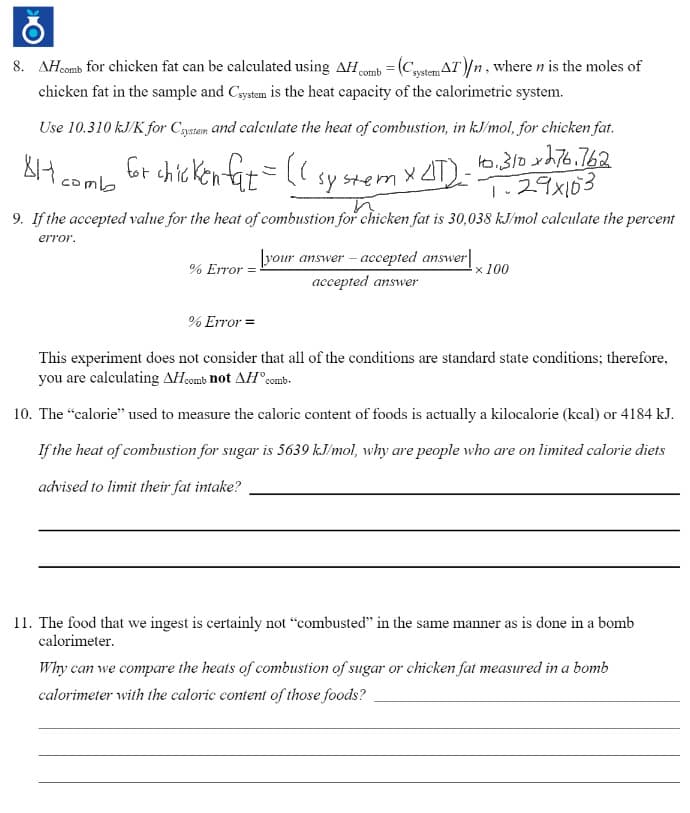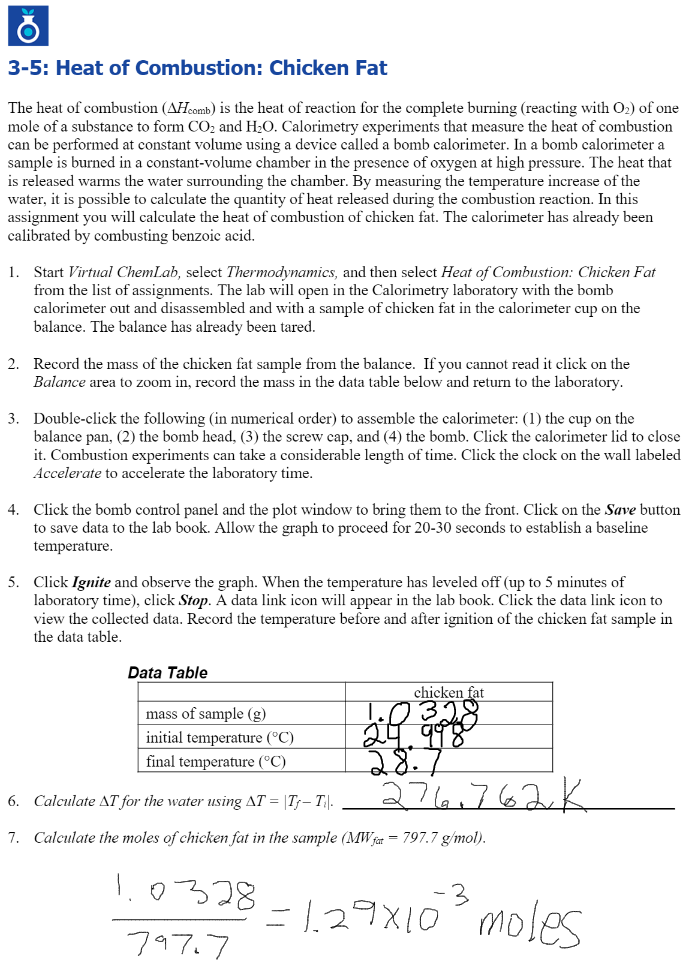8. AHecomb for chicken fat can be calculated using AH comb = (Cstem AT)/n , where n is the moles of chicken fat in the sample and Cystem is the heat capacity of the calorimetric system. Use 10.310 kJ/K for Cgystem and calculate the heat of combustion, in kJ/mol, for chicken fat. 84 comlo Gr chicken fit=( sy stem x T)- 310 xh76.162 29x163 9. If the accepted value for the heat of combustion for chicken fat is 30,038 kJ/mol calculate the percent error. |your answer - accepted answer| x 100 % Error accepted answer % Error = This experiment does not consider that all of the conditions are standard state conditions; therefore, you are calculating AHomb not AH°comb. 10. The "calorie" used to measure the caloric content of foods is actually a kilocalorie (kcal) or 4184 kJ. If the heat of combustion for sugar is 5639 kJ/mol, why are people who are on limited calorie diets advised to limit their fat intake? 11. The food that we ingest is certainly not "combusted" in the same manner as is done in a bomb calorimeter. Why can we compare the heats of combustion of sugar or chicken fat measured in a bomb
8. AHecomb for chicken fat can be calculated using AH comb = (Cstem AT)/n , where n is the moles of chicken fat in the sample and Cystem is the heat capacity of the calorimetric system. Use 10.310 kJ/K for Cgystem and calculate the heat of combustion, in kJ/mol, for chicken fat. 84 comlo Gr chicken fit=( sy stem x T)- 310 xh76.162 29x163 9. If the accepted value for the heat of combustion for chicken fat is 30,038 kJ/mol calculate the percent error. |your answer - accepted answer| x 100 % Error accepted answer % Error = This experiment does not consider that all of the conditions are standard state conditions; therefore, you are calculating AHomb not AH°comb. 10. The "calorie" used to measure the caloric content of foods is actually a kilocalorie (kcal) or 4184 kJ. If the heat of combustion for sugar is 5639 kJ/mol, why are people who are on limited calorie diets advised to limit their fat intake? 11. The food that we ingest is certainly not "combusted" in the same manner as is done in a bomb calorimeter. Why can we compare the heats of combustion of sugar or chicken fat measured in a bomb
Chemistry: The Molecular Science
5th Edition
ISBN:9781285199047
Author:John W. Moore, Conrad L. Stanitski
Publisher:John W. Moore, Conrad L. Stanitski
Chapter4: Energy And Chemical Reactions
Section: Chapter Questions
Problem 89QRT
Related questions
Question
Its the chicken fat not the water

Transcribed Image Text:8. AH.comb for chicken fat can be calculated using AH comb =(C,stemAT)/n, where n is the moles of
chicken fat in the sample and Cystom is the heat capacity of the calorimetric system.
Use 10.310 kJ/K for Cgstem and calculate the heat of combustion, in kJ/mol, for chicken fat.
Gr chic ken fat= ((
X AT)- .310 xh76.762
1.29x103
8H comb
sy stem
9. If the accepted value for the heat of combustion for chicken fat is 30,038 kJ/mol calculate the percent
error.
[your answer – accepted answer|
x 100
% Error
accepted answer
% Error =
This experiment does not consider that all of the conditions are standard state conditions; therefore,
you are calculating AHcomb not AH°comb-
10. The "calorie" used to measure the caloric content of foods is actually a kilocalorie (kcal) or 4184 kJ.
If the heat of combustion for sugar is 5639 kJ/mol, why are people who are on limited calorie diets
advised to limit their fat intake?
11. The food that we ingest is certainly not "combusted" in the same manner as is done in a bomb
calorimeter.
Why can we compare the heats of combustion of sugar or chicken fat measured in a bomb
calorimeter with the caloric content of those foods?

Transcribed Image Text:3-5: Heat of Combustion: Chicken Fat
The heat of combustion (AHcomb) is the heat of reaction for the complete burning (reacting with O2) of one
mole of a substance to form CO2 and H20. Calorimetry experiments that measure the heat of combustion
can be performed at constant volume using a device called a bomb calorimeter. In a bomb calorimeter a
sample is burned in a constant-volume chamber in the presence of oxygen at high pressure. The heat that
is released warms the water surrounding the chamber. By measuring the temperature increase of the
water, it is possible to calculate the quantity of heat released during the combustion reaction. In this
assignment you will calculate the heat of combustion of chicken fat. The calorimeter has already been
calibrated by combusting benzoic acid.
1. Start Virtual ChemLab, select Thermodynamics, and then select Heat of Combustion: Chicken Fat
from the list of assignments. The lab will open in the Calorimetry laboratory with the bomb
calorimeter out and disassembled and with a sample of chicken fat in the calorimeter cup on the
balance. The balance has already been tared.
2. Record the mass of the chicken fat sample from the balance. If you cannot read it click on the
Balance area to zoom in, record the mass in the data table below and return to the laboratory.
3. Double-click the following (in numerical order) to assemble the calorimeter: (1) the cup on the
balance pan, (2) the bomb head, (3) the screw cap, and (4) the bomb. Click the calorimeter lid to close
it. Combustion experiments can take a considerable length of time. Click the clock on the wall labeled
Accelerate to accelerate the laboratory time.
4. Click the bomb control panel and the plot window to bring them to the front. Click on the Save button
to save data to the lab book. Allow the graph to proceed for 20-30 seconds to establish a baseline
temperature.
5. Click Ignite and observe the graph. When the temperature has leveled off (up to 5 minutes of
laboratory time), click Stop. A data link icon will appear in the lab book. Click the data link icon to
view the collected data. Record the temperature before and after ignition of the chicken fat sample in
the data table.
Data Table
chicken fat
mass of sample (g)
initial temperature (°C)
final temperature (°C)
28.7
276,762K
6. Calculate AT for the water using AT = |T- T|-
7. Calculate the moles of chicken fat in the sample (MW fat = 797.7 g/mol).
1.0328
-3
= 1.29X10 moles
797.7
Expert Solution
This question has been solved!
Explore an expertly crafted, step-by-step solution for a thorough understanding of key concepts.
This is a popular solution!
Trending now
This is a popular solution!
Step by step
Solved in 3 steps

Knowledge Booster
Learn more about
Need a deep-dive on the concept behind this application? Look no further. Learn more about this topic, chemistry and related others by exploring similar questions and additional content below.Recommended textbooks for you

Chemistry: The Molecular Science
Chemistry
ISBN:
9781285199047
Author:
John W. Moore, Conrad L. Stanitski
Publisher:
Cengage Learning

Chemistry
Chemistry
ISBN:
9781305957404
Author:
Steven S. Zumdahl, Susan A. Zumdahl, Donald J. DeCoste
Publisher:
Cengage Learning


Chemistry: The Molecular Science
Chemistry
ISBN:
9781285199047
Author:
John W. Moore, Conrad L. Stanitski
Publisher:
Cengage Learning

Chemistry
Chemistry
ISBN:
9781305957404
Author:
Steven S. Zumdahl, Susan A. Zumdahl, Donald J. DeCoste
Publisher:
Cengage Learning


Chemistry: An Atoms First Approach
Chemistry
ISBN:
9781305079243
Author:
Steven S. Zumdahl, Susan A. Zumdahl
Publisher:
Cengage Learning

Chemistry for Engineering Students
Chemistry
ISBN:
9781337398909
Author:
Lawrence S. Brown, Tom Holme
Publisher:
Cengage Learning

General Chemistry - Standalone book (MindTap Cour…
Chemistry
ISBN:
9781305580343
Author:
Steven D. Gammon, Ebbing, Darrell Ebbing, Steven D., Darrell; Gammon, Darrell Ebbing; Steven D. Gammon, Darrell D.; Gammon, Ebbing; Steven D. Gammon; Darrell
Publisher:
Cengage Learning